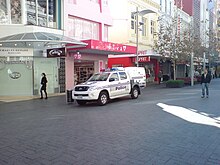
Crime in Australia is managed by various law enforcement bodies (federal and state-based police forces and local councils), the federal and state-based criminal justice systems and state-based correctional services.
The Department of Home Affairs oversees federal law enforcement, national security (including cyber security, transport security, criminal justice, emergency management, multicultural affairs, immigration and border-related functions). It comprises the Australian Federal Police, Australian Border Force, the Australian Security Intelligence Organisation, the Australian Criminal Intelligence Commission, the Australian Transaction Reports and Analysis Centre and the Australian Institute of Criminology as of February 2019[update].[1] Each state and territory runs its own police service.
The national justice system is overseen by the Attorney-General's Department, with each state and territory having its own equivalent.
Prison services are run independently by correctional services department in each state and territory.
Crime statistics are collected on a state basis and then collated and further analysed by the Australian Bureau of Statistics. Between 2008–09 and 2017–18, the national victimisation rate decreased for personal crime in all categories except sexual assault, and also all household crimes selected in the national statistics. Approximately 5.0% (966,600) of Australians aged 15 years and over experienced personal crime.[2]
- ^ "Home". Australian Government. Department of Border Affairs. Retrieved 26 February 2019.
- ^ "4530.0 - Crime Victimisation, Australia, 2017-18". Australian Bureau of Statistics. 13 February 2019. Retrieved 17 February 2019.